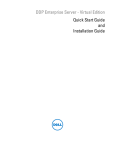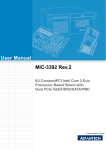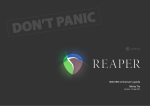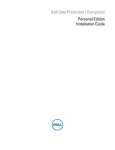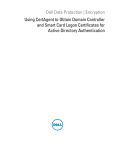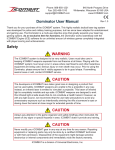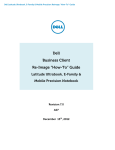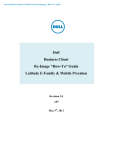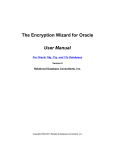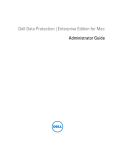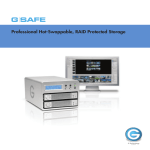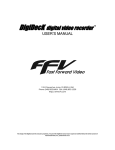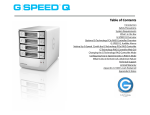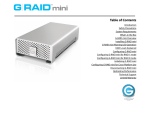Download Dell Data Protection | Encryption User's Manual
Transcript
Dell Data Protection | Cloud Edition User Guide ____________________ © 2014 Dell Inc. Registered trademarks and trademarks used in the DDP|E, DDP|ST, and DDP|CE suite of documents: Dell™ and the Dell logo, Dell Precision™, OptiPlex™, ControlVault™, Latitude™, XPS®, and KACE™ are trademarks of Dell Inc. Intel®, Pentium®, Intel Core Inside Duo®, Itanium®, and Xeon® are registered trademarks of Intel Corporation in the U.S. and other countries. Adobe®, Acrobat®, and Flash® are registered trademarks of Adobe Systems Incorporated. Authen Tec® and Eikon® are registered trademarks of Authen Tec. AMD® is a registered trademark of Advanced Micro Devices, Inc. Microsoft®, Windows®, and Windows Server®, Internet Explorer®, MS-DOS®, Windows Vista®, MSN®, ActiveX®, Active Directory®, Access®, ActiveSync®, BitLocker®, BitLocker To Go®, Excel®, HyperV®, Silverlight®, Outlook®, PowerPoint®, OneDrive®, SQL Server®, and Visual C++® are either trademarks or registered trademarks of Microsoft Corporation in the United States and/or other countries. VMware® is a registered trademark or trademark of VMware, Inc. in the United States or other countries. Box® is a registered trademark of Box. DropboxSM is a service mark of Dropbox, Inc. Google™, Android™, Google™ Chrome™, Gmail™, YouTube®, and Google™ Play are either trademarks or registered trademarks of Google Inc. in the United States and other countries. Apple®, Aperture®, App StoreSM, Apple Remote Desktop™, Apple TV®, Boot Camp™, FileVault™, iCloud®SM, iPad®, iPhone®, iPhoto®, iTunes Music Store®, Macintosh®, Safari®, and Siri® are either servicemarks, trademarks, or registered trademarks of Apple, Inc. in the United States and/or other countries. GO ID®, RSA®, and SecurID® are registered trademarks of EMC Corporation. EnCase™ and Guidance Software® are either trademarks or registered trademarks of Guidance Software. Entrust® is a registered trademark of Entrust®, Inc. in the United States and other countries. InstallShield® is a registered trademark of Flexera Software in the United States, China, European Community, Hong Kong, Japan, Taiwan, and United Kingdom. Micron® and RealSSD® are registered trademarks of Micron Technology, Inc. in the United States and other countries. Mozilla® Firefox® is a registered trademark of Mozilla Foundation in the United States and/or other countries. iOS® is a trademark or registered trademark of Cisco Systems, Inc. in the United States and certain other countries and is used under license. Oracle® and Java® are registered trademarks of Oracle and/or its affiliates. Other names may be trademarks of their respective owners. SAMSUNG™ is a trademark of SAMSUNG in the United States or other countries. Seagate® is a registered trademark of Seagate Technology LLC in the United States and/or other countries. Travelstar® is a registered trademark of HGST, Inc. in the United States and other countries. UNIX® is a registered trademark of The Open Group. VALIDITY™ is a trademark of Validity Sensors, Inc. in the United States and other countries. VeriSign® and other related marks are the trademarks or registered trademarks of VeriSign, Inc. or its affiliates or subsidiaries in the U.S. and other countries and licensed to Symantec Corporation. KVM on IP® is a registered trademark of Video Products. Yahoo!® is a registered trademark of Yahoo! Inc. This product uses parts of the 7-Zip program. The source code can be found at www.7-zip.org. Licensing is under the GNU LGPL license + unRAR restrictions (www.7-zip.org/license.txt). 2014-09 Protected by one or more U.S. Patents, including: Number 7665125; Number 7437752; and Number 7665118. Information in this document is subject to change without notice. Contents 1 Introduction Overview . . . . . . . . . . . . . . . . . . . . . . . . . . . . . . . . . . . . . . . . . . . . . . . . . . . . . . . . . . . . . . . . . . . . . . . . . . . . . . . . . . . . . . . . . . . . . . . . . . . . . . . Additional Support 2 Requirements Server . . . . . . . . . . . . . . . . . . . . . . . . . . . . . . . . . . . . . . . . . . . . . . . . . . . . . . . . . . . . . . . . . . . . . . . . . . . . . . . . . . . . . . . . . . . . . . . . . . . . . . . . . . . . . . . . . . . . . . . . . . . . . . . . . . . . . . . . . . . . . . . . . . . . . . . . Encryption Client . . . . . . . . . . . . . . . . . . . . . . . . . . . . . . . . . . . . . . . . . . . . . . . . . Required Components . . . . . . . . . . . . . . . . . . . . . . . . . . . . . . . . . . . . . . . . . . . . . . User Tasks 7 7 7 7 . . . . . . . . . . . . . . . . . . . . . . . . . . . . . . . . . . . . . . . . . . . . . . . . 8 . . . . . . . . . . . . . . . . . . . . . . . . . . . . . . . . . . . . . . . . . . . . . . . . . . . 8 . . . . . . . . . . . . . . . . . . . . . . . . . . . . . . . . . . . . . . . . . . . . . . . . . . . Prerequisites 5 7 Operating Systems 3 5 . . . . . . . . . . . . . . . . . . . . . . . . . . . . . . . . . . . . . . . . . . . Windows Client Hardware . Sync Clients. 5 . . . . . . . . . . . . . . . . . . . . . . . . . . . . . . . . . . . . . . . . . . . . . . . . . . . Install Cloud Edition . . . . . . . . . . . . . . . . . . . . . . . . . . . . . . . . . . . . . . . . . . . . . . . Activate Cloud Edition . . . . . . . . . . . . . . . . . . . . . . . . . . . . . . . . . . . . . . . . . . . . . 9 9 9 10 . . . . . . . . . . . . . . . . . . . . . . . . . . . . . . . . . . . . . . . . . . 10 Authenticate Dropbox for Business . . . . . . . . . . . . . . . . . . . . . . . . . . . . . . . . . . . . 11 Install a Cloud Sync Client . Sync Folders . . . . . . . . . . . . . . . . . . . . . . . . . . . . . . . . . . . . . . . . . . . . . . . . . . . . . . . . . . . . . . . . . . . . . . . . . . . . . . . . . . . . . . . . . . . . . 11 . . . . . . . . . . . . . . . . . . . . . . . . . . . . . . . . . . . . . . . . . . . . . . . . . . . . 11 Dropbox for Business Box . 11 OneDrive . . . . . . . . . . . . . . . . . . . . . . . . . . . . . . . . . . . . . . . . . . . . . . . . . . Work with Folders and Files . . . . . . . . . . . . . . . . . . . . . . . . . . . . . . . . . . . . . . . . . . 12 . . . . . . . . . . . . . . . . . . . . . . . . . . . . . . . . . . . . 13 . . . . . . . . . . . . . . . . . . . . . . . . . . . . . . . . . . . . . . . . . . . . . 13 Access a Cloud Storage Provider . Dropbox for Business. 12 Connect Cloud Edition and Dropbox . . . . . . . . . . . . . . . . . . . . . . . . . . . . . . . . . . . Use Dropbox for Business Context Menu . . . . . . . . . . . . . . . . . . . . . . . . . . . . . . . . . 13 . . . . . . . . . . . . . . . . . . . . . . . . . . . . . 13 . . . . . . . . . . . . . . . . . . . . . . . . . . . . . . . . 14 Use Business and Personal Dropbox Accounts Decrypting Folders in a Personal Account 13 User Guide 3 Understand the Dell Data Protection | Cloud Edition System Tray Menu Items. Details Screen . . . . . . . . . . . . . . . . 14 . . . . . . . . . . . . . . . . . . . . . . . . . . . . . . . . . . . . . . . . . . . . . . 14 Manage Folders Menu . . . . . . . . . . . . . . . . . . . . . . . . . . . . . . . . . . . . . . . . . . . . . Check for Policy Updates. 4 . . . . . . . . . . . . . . . . . . . . . . . . . . . . . . . . . . . . . . . . . . . Using Cloud Edition with iOS or Android Prerequisite . . . . . . . . . . . . . . . . . . . . . . . . . . . . . . . . . . . . . . . . . . . . . . . . . . . Install on an iOS device 17 Box . . . . . . . . . . . . . . . . . . . . . . . . . . . . . . . . . . . . . . . . . . . . . . . . . . . . . . . . . . . . . . . . . . . . . . . . . . . . Uninstall Cloud Edition . . . . . . . . . . . . . . . . . . . . . . . . . . . . . . . . . . . . . . . . . . . . . . . . . . . . . . . . . . . . . . . . . . . . . . . . . . . . . . . . . . 19 19 19 19 19 21 . . . . . . . . . . . . . . . . . . . . . . . . . . . . . . . . . . . . . . . . . . . . 21 . . . . . . . . . . . . . . . . . . . . . . . . . . . . . . . . . . . . . . . . . . . . . . . . . . 21 . . . . . . . . . . . . . . . . . . . . . . . . . . . . . . . . . . . . . . . . . . . . . . . . . . . . 21 Dropbox OneDrive . . . . . . . . . . . . . . . . . . . . . . . . . . . . . . . . . . . . . . . . . . . . . . . . . . Uninstall Cloud Edition . . . . . . . . . . . . . . . . . . . . . . . . . . . . . . . . . . . . . . . . . . . . . Frequently Asked Questions Folder Management FAQs Dropbox FAQs . 22 23 23 . . . . . . . . . . . . . . . . . . . . . . . . . . . . . . . . . . . . . . . . . . . . . . . . . 24 Miscellaneous FAQs User Guide . . . . . . . . . . . . . . . . . . . . . . . . . . . . . . . . . . . . 22 . . . . . . . . . . . . . . . . . . . . . . . . . . . . . . . . . . . . . . . . . . . . . . . . . . . . . . . . . . . . . . . . . . . . . . . . . . . . . . . . . . . . . . . . 24 . . . . . . . . . . . . . . . . . . . . . . . . . . . . . . . . . . . . . . . . . . . . . . 25 Box Sync Client FAQs 4 17 . . . . . . . . . . . . . . . . . . . . . . . . . . . . . . . . . . . . . . . . . . . . . . Remove Protected Files 7 17 . . . . . . . . . . . . . . . . . . . . . . . . . . . . . . . . . . . . . . . . . . . . . . . . . Download Cloud Edition . 6 . . . . . . . . . . . . . . . . . . . . . . . . . . . . . . . . . . . . . . . . . . . . . . . . . . . . . . . . . . . . . . . . . . . . . . . . . . . . . Share Files With External Users Register Cloud Edition . 17 17 Install on an Android device External User Tasks 17 . . . . . . . . . . . . . . . . . . . . . . . . . . . . . . . . . . . . . . . . Cloud Edition on an Android device End User Tasks 15 . . . . . . . . . . . . . . . . . . . . . . . . . . . . . . . . . . . . . . . . . . Cloud Edition on an iOS device 5 . . . . . . . . . . . . . . . . . . . . . . . . . . . 15 1 Introduction The Dell Data Protection | Cloud Edition User Guide provides the information needed to install and use Dell Data Protection | Cloud Edition (DDP|CE). Overview Dell Data Protection | Cloud Edition protects data in cloud-based file sharing systems. Windows computers using Dell Data Protection | Cloud Edition capture data intended for cloud storage, encrypt that data, and then upload that data into the cloud for secure storage. You can use Dell Data Protection | Cloud Edition (DDP|CE) on the following platforms: • Windows • iOS • Android Additional Support Should you need additional support beyond this document, contact your Administrator. User Guide 5 6 User Guide 2 Requirements Client hardware and software requirements are provided in this chapter. NOTE: IPv6 is not supported. Server Dell Data Protection | Cloud Edition (DDP|CE) requires that the client be connected to a Dell Data Protection Server. Encryption Client Although not required, Dell Data Protection | Cloud Edition can be used with Dell Data Protection | Encryption v7.2.4 or later. Required Components The installer installs these components if not already present on the computer. Required Components • Microsoft Visual C++ 2010 SP1 Redistributable Package (x86 and x64) • Microsoft .NET Framework 4.0 Client Profile Windows Client Hardware The following table details supported hardware for the Windows client. Windows Hardware • Intel Pentium-class or AMD processor • 512 MB-2 GB RAM, depending on operating system • 15 GB-20 GB free disk space, depending on operating system • 10/100/1000 or Wi-Fi network interface card • TCP/IP installed and activated User Guide 7 Operating Systems The following table details supported operating systems. Windows Operating Systems (32-bit and 64-bit) • Microsoft Windows 7 SP0-SP1 • Microsoft Windows 8 • Microsoft Windows 8.1 (Box and Dropbox only) Android Operating Systems • 4.0 Ice Cream Sandwich • 4.1-4.3 Jelly Bean • 4.4 KitKat iOS Operating Systems • iOS 5.x • iOS 6.x • iOS 7.x Sync Clients The following table details the latest tested sync clients. Sync clients release updates fairly frequently; later released versions may work properly with Cloud Edition, but should be tested prior to rolling out in a production environment. Sync Clients • Dropbox 2.4-2.12 - Dropbox for Business requires Dropbox version 2.8 or later NOTE: Depending on the Dell Data Protection Server used by your company, all files and folders in personal Dropbox accounts that are linked to business accounts may be encrypted. • Box 3.4, 4.0 • OneDrive 17.0 8 User Guide 3 User Tasks Windows clients can be installed using instructions provided by your Administrator. NOTE: For installation information for Android/iOS devices, see Using Cloud Edition with iOS or Android. Your policies have already been configured, so once you go through the quick and easy process, your device will work as it always has with one exception - corporate data will be secure. Prerequisites • Before deploying Dell Data Protection | Cloud Edition, it is best if you do not yet have Box, Dropbox, or OneDrive accounts set up. • Should you decide to keep an existing Box, Dropbox, or OneDrive account, you should ensure that any files that are to remain unencrypted are deselected before installing Dell Data Protection | Cloud Edition. Otherwise, your personal data might be encrypted. See Remove Protected Files. • Be prepared to restart your computer once DDP|CE is installed. • You must be a local Administrator on this computer to perform the installation. • DDP|CE does not interfere with the behavior of Dropbox, Box, or OneDrive. Therefore, Administrators and end users should familiarize themselves with how these applications work prior to deploying Dell Data Protection | Cloud Edition. See Cloud Storage Provider Help. Install Cloud Edition You must be a local Administrator on the computer to install Cloud Edition. NOTE: If your Administrator already installed Cloud Edition, go to Activate Cloud Edition. 1 Locate setup.exe in the Dell installation media. Copy it to the local computer. 2 Double click setup.exe to launch the installer. 3 If you get a Security Warning, click Run. 4 Select a language and click OK. 5 If prompted to install Microsoft Visual C++ 2010 Redistributable Package or Microsoft .NET Framework 4.0 Client Profile, click OK. 6 At the Welcome screen, click Next. 7 Read the license agreement, accept the terms, and click Next. 8 At the Destination Folder screen, click Next to install in the default location of C:\Program Files\Dell\Dell Data Protection\Cloud\. 9 In the Server Name: field, enter the Server Name that this computer will communicate with, such as server.domain.com. You do not need to include www or http(s). This information is supplied by your Administrator. Click Next. 10 In the Confirm Activation Server screen, confirm that the Server URL address is correct. The installer adds www or http(s) and the port. Click Next. User Guide 9 11 Click Install to begin the installation. A status window displays the installation progress. 12 Click Finish when the Installation Complete screen displays. 13 Click Yes to restart. Installation of Dell Data Protection | Cloud Edition is complete. Activate Cloud Edition After Dell Data Protection | Cloud Edition is installed and the computer reboots, follow these steps: 1 Log in to Windows. 2 In the system tray, click the Cloud Edition icon and select User Activation. 3 Enter your domain email address and domain password, and click Activate. After activation finishes, a green check displays on the Cloud Edition system tray icon. 4 Confirm your user mode status. Click the Cloud Edition system tray icon and select Details. 5 At the top, confirm User Mode: • Internal: A user with an email address within the company’s domain. • External: A user with a non-domain email address. Install a Cloud Sync Client NOTE: The installation steps will prompt you for the Server Name that this computer will communicate with, such as server.domain.com. This information is supplied by your Administrator. The best practice is to select and install just one sync client to work with Cloud Edition. If applicable, use your company’s preferred cloud sync client. 1 Click one of the following to install a sync client: • Dropbox (if your company allows business and personal accounts, this is the personal account) - see https://www.dropbox.com/install • Dropbox for Business - If your company has Dropbox for Business, your Administrator will provide you with a link for downloading and installing it. Your enterprise will determine if you can have a business account only or if you can use both business and personal folders. If you install Dropbox for Business, see Authenticate Dropbox for Business. • Box - see https://www.box.com/platform/ • OneDrive - see https://onedrive.live.com/about/en-us/download/ 2 In the sync client, create a shared folder or accept an existing one from another person or group in your company. If you are running one of the following, you can access a sync client folder from the system tray: • Dropbox/Dropbox for Business - Click the Dropbox icon and select Dropbox Folder. • Box - Right-click the Box icon and select Open Box Sync folder. • OneDrive - Click the OneDrive icon and select Open your OneDrive folder. 3 In Windows Explorer, you can use the sync client to create folders and upload files. NOTE: You can upload files using the browser. However, the best practice is to upload files through the sync client in Windows Explorer. For more information, see Sync Folders. 10 User Guide Authenticate Dropbox for Business If you install Dropbox for Business, Cloud Edition prompts for authentication. 1 After you install Cloud Edition, an Authentication window may open, or click the Cloud Edition icon and then select Dropbox > Connect. The Authentication window notifies you that Cloud Edition must have access to your Dropbox account and may give instructions about business and personal accounts. 2 At the Authentication window, click Next. 3 If a Network Threat Protection window opens, click Yes. 4 In the Authentication window, enter your domain email and Dropbox password. 5 If you have linked your Dropbox business and personal accounts, you will be prompted to select one now. You must select your business account. 6 At the next window, click Allow. 7 Click Finish or wait for the window to close. Sync Folders Select the instruction for one sync client. Dropbox for Business To sync folders: 1 In the system tray, click the Dropbox for Business icon. 2 Click the Settings icon, and select Preferences. 3 Click the Account tab, then click Selective Sync. 4 Select only folders or subfolders that you want to sync from your computer. 5 Click Update. 6 On the Update confirmation dialog, click OK. 7 On the Dropbox Preferences window, click OK. 8 A pop-up displays in the system tray that folders are being synced. Box To sync folders: 1 In the system tray, right-click the Box icon and select Open Box web site. 2 In the cloud, right-click a folder and select Sync Folder to Computer. 3 In the Sync folder window, click Sync Folder. 4 The system tray icon indicates settings are being applied. This may take several minutes. 5 When complete, navigate to Windows Explorer > Box Sync. The synced folders display with a check mark. User Guide 11 OneDrive To sync folders: 1 In the system tray, right-click the OneDrive icon, and click Settings. 2 Select the Choose Folders tab and then click Choose Folders. 3 Next, select Choose folders to sync. 4 A list of folders display. Select or clear check boxes to sync those folders. Click OK. 5 Click OK. 6 The system tray icon indicates settings are being applied. This may take several minutes. 7 When complete, navigate to Windows Explorer > OneDrive. The synced folders display with a check mark. Work with Folders and Files You can continue to use Dropbox, Box, or OneDrive to sync and continue working on files as you normally would. Depending on policy settings, when files are synced into the cloud, they are encrypted. Cloud Storage Provider Help Cloud Edition works transparently with your cloud sync client. Before using Cloud Edition, be sure to learn about the cloud storage provider: • Dropbox support at https://www.dropbox.com/help • Box support at https://support.box.com/home • OneDrive support at http://windows.microsoft.com/en-us/onedrive/onedrive-help#onedrive=other Follow instructions in the cloud storage provider help to do the following: • Create folders • Share folders or files • Edit encrypted files • Unshare folders Pre-existing Folders with Unencrypted Files When you install DDP|CE and have pre-existing folders that are now being synced by a sync client, DDP|CE will not encrypt them. Using Windows Explorer, one person within the group that shares that folder must move the files out of the sync client’s folder to a temporary location outside of the sync client’s folder. When the sync client folder indicates that it has completed syncing the changes, move the files back into the original folder. or For large content, request permission to have the Manage Folders option. Select that folder. 12 User Guide Access a Cloud Storage Provider Dropbox In the system tray, click the Dropbox icon and select Dropbox.com. NOTE: If you use Chrome or Firefox to open Dropbox.com, be sure to close it after you finish working with files and folders. Even if you open another tab in the browser, the content will be encrypted. This could include email, an attachment, or uploads using the browser. Box In the system tray, right-click the Box icon and select Open Box web site. OneDrive In the system tray, right-click the OneDrive icon and select Go to OneDrive.com. Dropbox for Business Dropbox for Business has specific requirements. See Sync Clients. Connect Cloud Edition and Dropbox If your company uses Dropbox for Business, you must allow Cloud Edition to stay connected. To connect: 1 In the system tray, click the Cloud Edition icon and then select Dropbox > Connect. 2 At the Dropbox Authentication window, read the information and then click Next. 3 If you have linked your Dropbox business and personal accounts, you will be prompted to select one now. You must select your business account. 4 At the prompt to allow Cloud Edition to access your Dropbox files and folders, click Allow. 5 Click Finish. Use Dropbox for Business Context Menu In Windows Explorer when Cloud Edition is installed, Dropbox for Business has an additional context menu. NOTE: You must connect Cloud Edition to Dropbox. To access the context menu, in Windows Explorer, open a Dropbox folder and right-click a file. The cloud icon has these options: • Share Secure Dropbox link • View on Dropbox.com • View previous versions Use Business and Personal Dropbox Accounts If your company has Dropbox for Business and also allows you to link a personal Dropbox account with your business account, be sure to understand the policies set by your administrator for those accounts. For example, a company can set the following policies: • Both business and personal files are encrypted. or • Only business files and folders are encrypted. Personal files remain unencrypted. For security, your enterprise may have an auditing policy. File names in the personal folder are logged and sent to the Dell Data Protection Server. If you use business and personal Dropbox accounts, do not store business files in your personal Dropbox folder. User Guide 13 Decrypting Folders in a Personal Account If a personal folder is accidentally encrypted, the Administrator can grant temporary access to allow you to manage encryption of your folders. Deselect folders that should be unencrypted. Also, you can remove folders from syncing by unlinking the account or unsyncing personal folders that should remain unencrypted. Understand the Cloud Edition System Tray Menu Items Details Screen The Cloud Edition Details screen provides helpful information, for example: • For technical support, you can provide status or version information. • To see an unobfuscated filename that is associated with a.xen file, select Files > File State. • To search for a filename, select Copy at the bottom right and paste the contents into a Word file. • To see who owns a folder, select Folders and scroll to the FOLDER OWNERSHIP column. To access the Details screen: Click the Cloud Edition system tray icon, and then click Details... The upper-left corner of the Details screen displays the following information: Service Status: Status of the Cloud Edition Windows Service. Values are: Stopped, StartPending, StopPending, Running, ContinuePending, PausePending, Paused Run State: The device activation state. Values are: Active, Reactivating, Suspended, Suspending User Mode: Internal user - a user within this domain address External user - a user outside of this domain address Registration Email: For Internal users, this is the domain email address. For External users, this is the email under which they registered. Server URL: DDP Server that communicates with this client. Policy Last Modified: Date and timestamp of when the policy was last modified and consumed by the client. Policy Version: Policy version generated by the DDP Server. The Files and Folders areas of the Details screen display the following information: Name: Name of the file or folder Key: Key ID assigned to that folder (new files use that key for encryption) Sync Client: The last sync client to sync that folder (Dropbox, Box, or OneDrive) FolderOwnership: This value indicates who the folder is owned by. Value is determined by the Key ID. FolderState: The folder state is typically Idle unless a sync client is working on a folder, in which case it would be Enumerating. Obfuscation Type: A set on each folder indicating what type of .xen files will be created in the cloud. This is a policy set by your Administrator. If your Administrator selects Extension only, the actual filename with the “.xen” extension will be displayed. If your Administrator selects Guid, a scrambled filename with the “.xen” extension will display. This setting takes effect on new folders only. To view log files, from the bottom-left corner of the Details screen, click View Log. NOTE: Log files can be also be found at C:\ProgramData\Dell\Dell Data Protection\Cloud Edition. 14 User Guide Manage Folders Menu Based on policy, your Administrator grants access to this screen. This feature is allowed or denied by policy and enables the management of encryption on a folder-by-folder basis within the sync client folders. To access the Manage Folders screen, click the Dell Data Protection | Cloud Edition system tray icon and select Manage Folders. If this feature is not enabled by policy, Manage Folders does not display in the menu. Additionally, when the policy is enabled, the menu item does not display until you have created a folder, added files, and those files are encrypted up to the cloud. A hierarchical view of cloud synchronized folders on the computer displays for each sync client. All folders are selected by default, although you can deselect folders you do not wish to encrypt. Check for Policy Updates If your Administrator modifies a policy and notifies you of a policy update, go to the Windows system tray, click the Dell Data Protection | Cloud Edition icon, and select Check for Policy Updates. User Guide 15 16 User Guide 4 Using Cloud Edition with iOS or Android This section describes basic information on installing Cloud Edition on iOS or Android devices as well as a few tips. When using Cloud Edition on an iOS or Android client, if you open files directly through Dropbox, Box, or OneDrive, the file names and file contents are encrypted and unreadable. NOTE: Be aware that Windows has more options for sync clients than some other devices. For example, on some mobile devices, you can open and view Dropbox, Box, and OneDrive files, but you cannot upload a change. Prerequisite Before you install DDP|CE, you need the name of your enterprise’s Dell Data Protection Server, such as server.domain.com. This information is supplied by your Administrator. Cloud Edition on an iOS device Install on an iOS device 1 On your device, tap App Store and search for Dell Data or Cloud Edition. 2 Select and install the Dell Data Protection |Cloud Edition app. 3 For the Server field at the login screen, enter the name of your company’s Dell Data Protection Server, such as server.domain.com. 4 Select a cloud storage provider: Dropbox, Box, or OneDrive. Cloud Edition on an Android device Install on an Android device 1 On your device, access Google Play and search for DDP. 2 Select and install the DDP Cloud Edition app. 3 For the Server field at the login screen, enter the name of your company’s Dell Data Protection Server, such as server.domain.com. 4 Enter your user name and password and click Login. 5 Select a cloud storage provider: Dropbox, Box, or OneDrive. User Guide 17 18 User Guide 5 Share Files With External Users An external user is one with a non-domain email address. If an internal user wants to work on or share files protected by Cloud Edition with an external user, this must be coordinated between the internal user and the Administrator. End User Tasks Before you share files with an external user, check with your Administrator. You may need to submit a request to allow an external user to register with Cloud Edition. In the cloud storage provider, invite an external user to share a file or folder. External User Tasks The external user must have Administrator rights on their computer in order to install Dell Data Protection | Cloud Edition (DDP|CE). Register Cloud Edition The external user must do the following: 1 When you receive a registration email, click the link. 2 At the Registration web page, enter your email address and password. Confirm your password, and click Register. 3 A confirmation email will be sent to you. Follow the link in the email. 4 Log in using the same email address and password you used to register. Registration is complete. A Cloud Edition download page opens. Download Cloud Edition 1 Select Windows or a device on which to install Cloud Edition. 2 When prompted for the server name, use the name at the top of the Download page. User Guide 19 20 User Guide 6 Uninstall Cloud Edition Typically, the Administrator uninstalls Cloud Edition. NOTE: An external user who has been invited to share a folder and has Administrator rights on an external computer may also uninstall Cloud Edition. Remove Protected Files All encrypted documents on the device must be removed from the local computer. Choose one of the following methods to remove protected files: • Recommended method: Turn off syncing from the sync folders. All folders and files will remain in the cloud but will be removed from the local device. • Delete the files directly from the cloud and allow syncing to occur. The cloud service will show there are no files on the device. When syncing occurs the local device will remove all data from the shared folder. • Delete the files directly from the local sync folder. The sync client will observe the change and remove all files from the cloud service. Dropbox 1 In the system tray, select the Dropbox icon, and click the Settings icon. 2 In Preferences, click the Account tab, and then Selective Sync. 3 Deselect folders to remove syncing. 4 Click Update. 5 At the confirmation dialog, click OK. (The folders will be removed from Dropbox on the computer but are still available on the web and other devices.) 6 At the Dropbox Preferences window, click OK. 7 The system tray icon indicates settings are being applied. This may take several minutes. 8 When the Dropbox icon indicates that remove syncing is complete, navigate to Windows Explorer > Dropbox. If any files or folders were not removed, manually delete them. Box 1 In the system tray, right-click the Box icon and select Open Box web site 2 In the Box web site, right-click a file or folder and select Synced > Unsync. 3 In the Disable Sync window, click Unsync Folder. 4 The system tray icon indicates settings are being applied. This may take several minutes. 5 When complete, navigate to Windows Explorer > Box. If any files or folders were not removed, manually delete them. User Guide 21 OneDrive 1 In the system tray, right-click the OneDrive icon, and click Settings. 2 Select the Choose Folders tab and then click Choose Folders. 3 Then, select Choose folders to sync. 4 When the list of folders displays, clear the check boxes to remove syncing and click OK. 5 Click OK. 6 The system tray icon indicates settings are being applied. This may take several minutes. 7 When complete, navigate to Windows Explorer > OneDrive. If any files or folders were not removed, manually delete them. Uninstall Cloud Edition You must be a local Administrator on the computer to uninstall Cloud Edition. 1 Use the Windows Control Panel to uninstall the program. 2 Select Dell Data Protection | Cloud Edition and click Change on the top menu. 3 Click Next when the Welcome screen displays. 4 Select Remove and click Next. 5 A warning displays to confirm if you want to uninstall Dell Data Protection | Cloud Edition. If so, click Next. NOTE: If you still have protected files on the system, a dialog displays prompting you to remove protected files. You must either stop synchronization of those folders or delete the files before continuing. See Remove Protected Files. When you finish, return to the InstallShield Wizard and click OK. 6 Click Remove to remove Dell Data Protection | Cloud Edition. A status window displays the progress. 7 If you get an error dialog from the sync client, click Continue. 8 Click Finish when the Completed screen displays. 9 Click Yes to restart. Uninstallation of Dell Data Protection | Cloud Edition is complete. Remove Protected Files While uninstalling, if a dialog states that you have protected files, you must remove them. 1 In the system tray, click the Cloud Edition icon and select Details. 2 In the Files column, note any files that prevent uninstalling. 3 In Windows Explorer, cut each file from the sync folder and paste it to a temporary location. 4 Return to step 6 and continue to uninstall. 22 User Guide 7 Frequently Asked Questions Folder Management FAQs NOTE: To use the Manage Folders option, you may need to request permission from your Administrator. Question I have a folder with files that I have shared with another user. In the system tray, I used the Cloud Edition > Manage Folders utility to unprotect that folder's contents. Recently, my files have become encrypted in the cloud again. That folder no longer displays in the Manage Folders utility, so I can no longer get those files to become unprotected in the cloud. Answer An encryption key ID is associated with a folder based on the first user who adds a file to that folder. If one user creates a folder and does not add any files, their key is not associated with that folder. The user whose encryption key ID has been set on the folder is the only one who can view the folder in the Manage Folders utility. If the user who sees the folder deselects the folder in the Manage Folders utility and they share that folder with another DDP|CE user, the second user’s DDP|CE will re-encrypt the contents. Solution 1 Create a new folder. 2 Move all the files to be protected to the new folder. 3 In the system tray, use the Cloud Edition > Manage Folders utility again to decrypt those files. NOTE: If you unprotect the contents of a folder that are shared with other users who have DDP|CE, the other user’s DDP|CE will enforce the policy to encrypt them. You can use the Manage Folders utility to unprotect files that are unshared with other DDP|CE users. The best practice is to unprotect only unshared folders. Question I am syncing to a decrypted folder that I had deselected using the Manage Folders utility. However, when I try to upload it through the web browser, I can only upload encrypted files. Answer DDP|CE is not designed to actively search for folders in the cloud. With unencrypted folders, DDP|CE can sync through the sync client because it is controlling that environment. Files going through the web browser are required to be protected. Solution Add files to the sync folder. User Guide 23 Question I recently uninstalled my cloud-based file sharing system (Dropbox, Box, or OneDrive) from my computer, but when I opened the Manage Folders utility, Dropbox was still listed as an option. Answer DDP|CE does not monitor installation or uninstallation of third-party software. Those options are still listed because, by design, when these clients are uninstalled, they do not remove your existing files. Those files are still being protected by DDP|CE even though that sync client is no longer there. Solution To remove the old sync client option from the Manage Folders utility, delete the folder that houses those protected files. The best practice is to move any wanted folders/files out of the default Sync folder prior to deleting it. After you remove it, that file or folder is no longer listed in the Folder Management utility. Dropbox FAQs Question My Dropbox account has many conflicted files. When I delete them from the cloud, they keep being created. Answer Sometimes, when a folder has already been shared and then multiple Cloud Edition accounts are activated at the same time, these files are seen as being created at the same time. In an effort to preserve the original, Dropbox will create multiple files of the same name and type and place them into the cloud. Therefore, Cloud Edition will allow all the files to be created without interfering. Solution 1 Everyone who is sharing that file must collaborate on deselecting that folder for sync from the Dropbox application. See Dropbox for Business. 2 After all the files and the folder have been removed from each local machine, one person must access the cloud and delete the duplicate files. Then, each person can use the selective sync to re-add the folder to be synced. Box Sync Client FAQs Question I am using the Box sync client. I created a new folder locally and added some files. The sync client appears to be working, but nothing has been created in the cloud. Answer The Box sync client may require some time to collect information about new folders and files. The process can take several minutes compared to other sync clients. Be sure to wait for several minutes for the sync client to complete before creating new folders and files. 24 User Guide Question I am using the Box sync client. I ran out of room on my primary partition, so I moved it to another drive. Now, the My Box Files folder has one or more folders created and named New Folder. Answer Currently, when files are being synced between two machines to the same file share, if one person moves that folder to another location, then any new folders that other people create in that file share will create an empty folder named New Folder. Solution Delete the New Folder directly from the cloud. It will be removed from all systems that are sharing that folder. Miscellaneous FAQs Question I moved the cloud provider’s sync folder to Program Files, and now I cannot decrypt the files that are being downloaded to my sync folder from the cloud. Answer By design, the Program Files folder or other excluded folders are unprotected, based on policy. DDP|CE will not decrypt any files downloaded to this folder or its subfolders. Solution Unlink or uninstall the sync client and move the sync folder back to its default location or to an alternate managed location. NOTE: For a list of managed and unmanaged locations, contact your Administrator. Question I had some archived .xen files, and I copied them to my desktop. Some of them decrypted, but others did not. Answer During a sync, DDP|CE is designed to decrypt directly to the Sync folder or decrypt when downloading through a web browser. For files that have been copied from another location, use Windows Explorer and move the .xen file into the sync client folder to be decrypted. In the system tray, click the Cloud Edition icon and then select Details. Locate the .xen file and its key to determine if that provides any information. Solution Move the .xen files into the Sync folder to have them uploaded into the cloud. Then, they will be decrypted locally. Question I renamed my computer. Now, I am not getting any policy updates, and I am not encrypting into the cloud. Answer Currently, the Server only recognizes the endpoint against which you originally activated. If you change the endpoint name, the Server will not recognize the location for sending the policy and DDP|CE will not perform as expected. User Guide 25 Solution 1 Uninstall DDP|CE and then reinstall. You must have Administrator rights to uninstall. 2 Activate the same user again. NOTE: Ensure that you stop syncing files to the local computer before you do this, or you will run the risk of having valuable data become unprotected in the cloud or possibly deleted. Question On suspended Windows devices, when I try to upload files into the cloud, nothing happens. When I close the windows that were already opened, an error message states, Access Denied. Answer The error message is not from DDP|CE. You can access the files locally but will not get future updates to the files. 26 User Guide 0XXXXXA0X




























